An emergency fund is a financial safety net designed to cover unexpected expenses and financial emergencies. This fund is typically held in a liquid savings account, making it easily accessible in times of need.
The primary purpose of an emergency fund is to provide financial stability and security, allowing individuals and families to navigate unforeseen circumstances without resorting to debt or compromising their financial health.

Why is it Important?
One of the most significant benefits of an emergency fund is the peace of mind it provides. Knowing that you have a financial cushion to fall back on in times of crisis can alleviate stress and anxiety.
This financial security allows you to focus on resolving the emergency rather than worrying about how to pay for it.
Without It, unexpected expenses often lead to high-interest debt, such as credit card balances or payday loans. An emergency fund can prevent you from accumulating such debt, which can be difficult to pay off and can damage your credit score.
By having a reserve of cash, you can cover emergency expenses without incurring additional financial burdens.
This fund provides financial flexibility, allowing you to make better decisions during a crisis. For example, if you lose your job, it can cover your living expenses while you search for new employment.
This buffer gives you the flexibility to find a job that fits your skills and career goals, rather than taking the first available position out of financial necessity.
How Much Should You Save?
General Guidelines
Financial experts generally recommend saving three to six months’ worth of living expenses in an emergency fund. This amount can vary depending on your personal circumstances, such as job stability, health, and family size.
For example, if you have a stable job and low living expenses, three months’ worth of savings might be sufficient. However, if you have a family, variable income, or health issues, you might aim for six months or more.
Tailoring to Individual Needs
Consider your specific financial situation when determining the size of your fund. Assess your monthly expenses, including rent or mortgage, utilities, groceries, transportation, and insurance. Additionally, consider any regular payments for loans or other financial obligations.
Tailoring your emergency fund to your unique needs ensures that you have an adequate cushion to cover your expenses in an emergency.
Start Small and Be Consistent
Building an emergency fund can seem daunting, but starting small and being consistent is key. Begin by setting aside a small amount of money each month, even if it’s just $20 or $50. Over time, these small contributions will add up and help you establish a solid financial foundation.
Automate Your Savings
Automating your savings is an effective way to build your emergency fund. Set up automatic transfers from your checking account to your savings account on payday. This ensures that a portion of your income is consistently saved without requiring conscious effort. Automation also reduces the temptation to spend the money on non-essential items.
Prioritize Your Emergency Fund
Make building your emergency fund a financial priority. Review your budget and identify areas where you can cut back on discretionary spending, such as dining out or entertainment. Redirect these funds into your emergency savings. By prioritizing your emergency fund, you can achieve your savings goals more quickly.
Where to Keep Your Emergency Fund
The best place to keep your emergency fund is in a high-yield savings account. These accounts offer higher interest rates than traditional savings accounts, allowing your money to grow while remaining easily accessible. Ensure that the account is FDIC-insured to protect your savings.
Money market accounts are another option for storing your emergency fund. These accounts typically offer higher interest rates than standard savings accounts and come with check-writing privileges and debit cards for easy access. However, be aware of any fees or minimum balance requirements associated with money market accounts.
While it might be tempting to invest your emergency fund in stocks or other high-risk investments for higher returns, this approach is not recommended. The primary purpose of an emergency fund is liquidity and safety, not growth. Investing in volatile assets can put your emergency savings at risk, defeating the purpose of having a financial safety net.
Using Your Emergency Fund Wisely
Clearly define what constitutes it to avoid dipping into your fund for non-essential expenses. Genuine emergencies might include unexpected medical bills, car repairs, job loss, or urgent home repairs. Avoid using your emergency fund for planned expenses or discretionary spending, such as vacations or luxury purchases.
If you need to use your fund, make it a priority to replenish it as soon as possible. After the emergency has passed, review your budget and financial situation to determine how much you can save each month to rebuild your fund. Replenishing your fund ensures that you are prepared for future unexpected expenses.
Periodically review your fund to ensure it still meets your needs. Life changes such as a new job, marriage, or the birth of a child can affect your financial situation and require adjustments to your emergency savings. Regular reviews help you maintain an adequate safety net.
Conclusion
An emergency fund is an essential component of a healthy financial plan, providing security, flexibility, and peace of mind. By understanding its importance, determining the appropriate amount to save, and implementing practical strategies for building and maintaining your fund, you can safeguard your financial well-being against life’s uncertainties. Start small, be consistent, and prioritize your emergency savings to achieve long-term financial stability.



